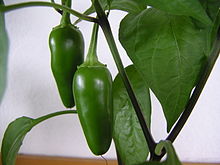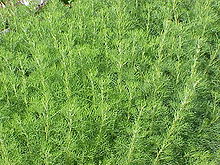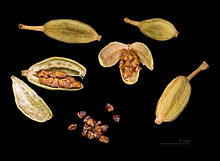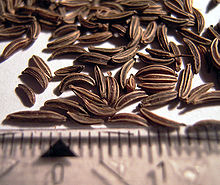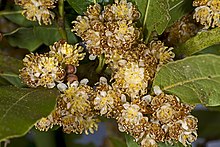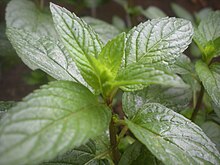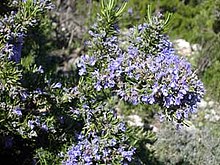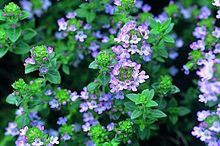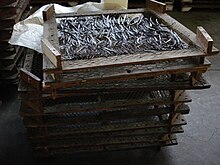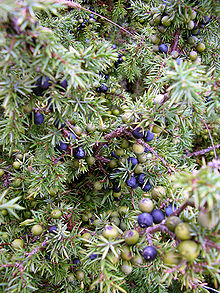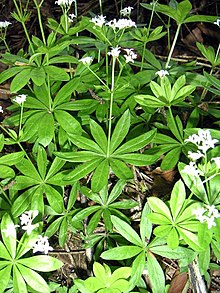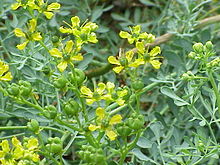List of culinary herbs and aromatic plants
The list of culinary herbs and aromatic plants includes cultivated plants and wild species, of which components are used regionally or worldwide as spices in the kitchen and in the food industry (e.g. for desserts and liqueurs ) because of their aroma . These are presented in a simple botanical system , in particular the system of the bedecktsamer .
Often one can infer a similar appearance, a similar taste or similar active ingredients from belonging to the same plant family or genus . Among the more frequently represented plant families among the aromatic plants include mint (including basil , thyme , marjoram , rosemary , savory , sage , lavender , mint , lemon balm ), Umbelliferae ( anise , caraway , coriander , dill , parsley , lovage , parsley and celery and others) and leeks ( garlic , leek , chives and wild garlic ).
Some of these plants are medicinal plants , so they also have pharmacological effects. As an aphrodisiac are nutmeg and parsley .
list
Conifers
The conifers or softwoods (Coniferales, often also Pinales), also called "pine-like", are the largest group of naked-seed plants still alive today.
- Pine family (Pinaceae)
The following types are used for the extraction of spruce needle oils or thujones .
- Black spruce ( Picea mariana )
- White spruce ( Picea glauca )
- Canadian hemlock ( Tsuga canadensis )
- Cypress family (Cupressaceae)
- Common Juniper ( Juniperus communis )
Furrow pollen dicotyledonous
The Einfurchenpollen-dicotyledonous ( Magnoliopsida ) formed a taxon of plants from the division of the bedecktsamer ( Magnoliophyta ) in some classifications . In current systematics, they no longer form their own taxon, since they are paraphyletic, but are summarized under the term basic orders.
- Annonaceous (Annonaceae)
- Carrot Pepper ( Xylopia aethiopica )
- Ylang-Ylang ( Cananga odorata )
- Calabash nutmeg ( Monodora myristica )
- Star anise family (Schisandraceae)
- Real star anise ( Illicium verum )
- Laurel family (Lauraceae)
- Ceylon cinnamon tree ( Cinnamomum verum )
- Cinnamon cassia ( Cinnamomum cassia )
- Rosewood ( Aniba rosaeodora )
- Clove cinnamon ( Dicypellium caryophyllaceum )
- Laurel ( Laurus nobilis )
- Sassafras tree ( Sassafras albidum )
- Nutmeg family (Myristicaceae)
- Nutmeg tree ( Myristica fragrans )
- Pepper family (Piperacaeae)
- Makulan ( Piper auritum )
- Pepper ( Piper nigrum )
- Cubeb pepper ( Piper cubeba )
- Long pepper ( Piper longum )
- Tasmanian mountain pepper ( Tasmannia lanceolata )
Monocots
The monocotyledons or monocotyledons are one of the large groups of flowering plants. Essentially, it is herbaceous plants, mostly perennial plants, tree-shaped life forms such as palms are also included. Monocot plants are found in almost every habitat on earth.
- Arum family (Araceae)
- Sweet flag ( Acorus calamus )
- Narrow-leaved sweet flag ( Acorus gramineus )
- Ginger family (Zingiberaceae)
- Green cardamom ( Elettaria cardamomum )
- Grains of Paradise ( Aframomum melegueta )
- Black cardamom ( Amomum subulatum )
- Thai ginger ( Alpinia galanga )
- Mango ginger ( Curcuma amada )
- Turmeric ( Curcuma longa )
- Lemon root ( Curcuma zedoaria )
- Spice lily ( Kaempferia galanga )
- Ginger ( Zingiber officinale )
- Leek family (Alliaceae)
- Shallot ( Allium ascalonium )
- Winter onion ( Allium fistulosum )
- Leeks ( Allium porrum )
- Garlic ( Allium sativum )
- Floor onion ( Allium cepa var. Proliferum )
- Snake leek ( Allium scorodoprasum )
- Chives ( Allium schoenoprasum )
- Garlic Chives ( Allium tuberosum )
- Wild garlic ( Allium ursinum )
- Stingray family (Smilacaceae)
- Veracruz bindweed ( Smilax aristolochiifolia )
- Honduran bindweed ( Smilax regulii )
- Orchids (orchidaceae)
- Spiced Vanilla ( Vanilla planifolia )
- Banana Vanilla ( Vanilla pompona )
- Tahitian vanilla ( Vanilla tahitensis )
- Salep (various bulbs of earth orchids)
- Iris family (Iridaceae)
- Saffron ( crocus sativus )
- Sweet grasses (Poaceae or Gramineae)
- Lemongrass ( Cymbopogon citratus )
- Malabar grass ( Cymbopogon flexuosus )
- Fragrant Mariengrass ( Hierochloe odorata )
- Vetiver ( Vetiveria zizanioides )
Three-furrow pollen dicotyledonous
The three-furrow pollen dicotyledonous or Rosopsida form a taxon of plants from the department of flowering plants. In the vegetative area, the Rosopsida can hardly be distinguished from the remaining dicotyledons.
- Acanthus family (Acanthaceae)
- Mushroom herb ( Rungia klossii )
- Annatto family (Bixaceae)
- Annatto shrub ( Bixa orellana )
- Valerian family (Valerianaceae)
- Real medicinal valerian ( Valeriana officinalis )
- Boraginaceae (Boraginaceae)
- Umbelliferae (Apiaceae / Umbelliferae)
- Dill ( anethum graveolens )
- Medicinal angelica ( Angelica archangelica )
- American angelica ( Angelica atropurpurea )
- Chervil ( Anthriscus cerefolium )
- Celery ( Apium graveolens var. Dulce )
- Black cumin ( Bunium persicum )
- Real caraway ( Carum carvi )
- Coriander ( Coriandrum sativum )
- Mitsuba ( Cryptotaenia japonica )
- Cumin ( Cuminum cyminum )
- Long coriander , Mexican coriander, culantro ( Eryngium foetidum )
- Asant ( Ferula asafoetida )
- Fennel ( Foeniculum vulgare )
- Berg-Laserkraut , Bergkümmel ( Laserpitium siler )
- Lovage ( Levisticum officinale )
- Bearwort ( Meum athamanticum )
- Sweet umbel ( Myrrhis odorata )
- Parsnip ( Pastinaca sativa )
- Parsley ( Petroselinum crispum )
- Aniseed ( Pimpinella anisum )
- Great Bibernelle ( Pimpinella major )
- Little Bibernelle ( Pimpinella saxifraga )
- Ajowan ( Trachyspermum ammi )
- Verbena plants (Verbenaceae)
- Lemon bush ( Aloysia citrodora )
- Mexican oregano ( Lippia graveolens )
- Foxtail family (Amaranthaceae)
- Mexican goosefoot ( Dysphania ambrosioides )
- Gelaceae family (Myricaceae)
- Gail Shrub ( Myrica gale )
- Buttercup Family (Ranunculaceae)
- Black cumin ( Nigella sativa )
- Maiden in the Green ( Nigella damascena )
- Hemp plants (Cannabaceae)
- Heather family (Ericaceae)
- Lower shamrock ( Gaultheria procumbens )
- Legumes (Fabaceae)
- Tonka bean ( Dipteryx odorata )
- Soumbala ( Parkia biglobosa )
- Tamarind tree ( Tamarindus indica )
- Fenugreek ( Trigonella foenum-graecum )
- Shabby clover ( Trigonella caerulea )
- Capers (Capparaceae)
- Real caper bush ( Capparis spinosa )
- Nasturtium family (Tropaeolaceae)
- Nasturtium ( Tropaeolum majus )
- Knotweed family (Polygonaceae)
- Water pepper ( Persicaria hydropiper )
- Common Sorrel ( Rumex acetosa )
- Shield-leaved dock ( Rumex scutatus )
- Daisy family (Asteraceae)
- Common yarrow ( Achillea millefolium )
- Nutmeg sheaf ( Achillea decolorans )
- Roman chamomile ( Anthemis nobilis )
- Wormwood ( Artemisia absinthium )
- Mugwort ( Artemisia vulgaris )
- Pale-leaved mugwort ( Artemisia pallens )
- Tarragon ( Artemisia dracunculus )
- Common wedge ( Artemisia abrotanum )
- Marigold ( Calendula officinalis )
- Ladymint ( Chrysanthemum balsamita )
- Tansy ( Chrysanthemum vulgare )
- Canadian fleabane ( Erigeron canadensis )
- Curry herb , Italian straw flower ( Helichrysum italicum )
- Elecampane ( Iluna helenium )
- Chamomile ( Matricaria chamomilla )
- Bolivian coriander , Peruvian coriander ( Porophyllum ruderale )
- Goldenrod ( Solidago odora )
- Huacatay ( Tagetes minuta )
- Common dandelion ( Taraxacum officinale )
- Yacón ( Smallanthus sonchifolia )
- Cruciferous family (Brassicaceae, formerly Cruciferae)
- Garlic mustard ( Alliaria petiolata )
- Horseradish ( Armoracia lapathifolia )
- Black mustard ( Brassica nigra )
- Spoonbill herb ( Cochlearia officinalis )
- Arugula , rocket ( Eruca sativa )
- Wasabi ( Eutrema japonica )
- Pepper herb ( Lepidium latifolium )
- Garden cress ( Lepidium sativum )
- Watercress ( Nasturtium officinale )
- White mustard ( Sinapis alba )
- Mint family (Lamiaceae, Labiatae)
- Alpine stone quendel , stone mountain mint ( Acinos alpinus )
- Scented nettle ( Agastache foeniculum )
- Koreaminze , East Asian giant sysop ( Agastache rugosa )
- Mexican anisysop ( Agastache mexicana )
- Nindi ( Aeolanthus heliotropoides and Aneoanthus pubescens )
- Spanish thyme , Jamaican thyme ( Plectranthus amboinicus )
- Stone mint ( Cunila origanoides )
- Real lavender ( Lavandula angustifolia )
- Speik lavender ( Lavandula latifolia )
- Coppy Lavender ( Lavandula stoechas )
- Real betony ( betonica officinalis )
- Knollen-Ziest , Stachy ( Stachys affinis )
- Sage germander ( Teucrium scorodonia )
- Edelgamander ( Teucrium chamaedrys )
- Hyssop , real hyssop ( Hyssopus officinalis )
- Gundelrebe , Gundermann ( Glechoma hederacea )
- Mosquito plant , American pennyroyal ( Hedeoma pulegioides )
- Sangura ( Hyptis suaveolens )
- Horehound ( Marrubium vulgare )
- Corn mint , corn mint ( Mentha arvensis )
- Bachmint ( Mentha aquatica )
- Bergamotmint ( Mentha citrata )
- Edelmint ( Mentha × gentilis )
- Horse mint, long-leaved mint, white mint ( Mentha longifolia )
- Yerba buena ( Mentha nemorosa and Mentha sativa )
- Peppermint ( Mentha × piperita )
- Pennyroyal ( Mentha pulegium )
- Pineapple mint ( Mentha rotundifolia var. Variegata )
- Spearmint ( Mentha spicata )
- Spearmint ( Mentha spicata var. Crispa )
- Round-leaved mint ( Mentha suaveolens )
- English horse mint ( Mentha × villosa-nervata )
- Melissa , lemon balm ( Melissa officinalis )
- Golden balm ( Monarda didyma )
- Wild golden balm ( Monarda fistulosa )
- Lemon balm ( Monarda citriodora )
- Catnip ( Nepeta cataria )
- Basil ( Ocimum basilicum )
- Cretan diptame ( Origanum dictamnus )
- Fever plant ( Ocimum viride )
- Oregano , wild marjoram ( Origanum vulgare )
- Greek oregano ( Origanum vulgare subsp. Hirtum )
- Marjoram , Annual Marjoram ( Origanum majorana )
- Syrian hyssop ( Origanum syriacum )
- Perilla ( Perilla frutescens )
- Comb mint ( Elsholtzia ciliata )
- Rosemary ( Rosmarinus officinalis )
- Common savory , savory ( Satureja hortensis )
- Mountain savory , winter savory ( Satureja montana )
- Honeydew melon sage , pineapple sage ( Salvia elegans )
- Common sage ( Salvia officinalis )
- Meadow sage ( Salvia pratensis )
- Clary sage ( Salvia sclarea )
- Real thyme , garden thyme ( Thymus vulgaris )
- Sand thyme ( Thymus serpyllum )
- Forest thyme ( Thymus mastichina )
- Head thyme ( Thymbra capitata )
- Myrtle family (Myrtaceae)
- Clove , clove tree ( Syzygium aromaticum )
- Myrtle ( Myrtus communis )
- Eucalyptus ( eucalyptus )
- Allspice ( Pimenta dioica )
- Indonesian bay leaf ( Syzygium polyanthum )
- Nightshade family (Solanaceae)
This family also includes eggplant ( Solanum melongena ) and tomato ( Solanum lycopersicum ). Experts distinguish over 2000 types of paprika, chilli peppers and chillies from the Capsicum genus . The spiciness is due to the capsaicin content .
- Spanish pepper ( Capsicum annuum )
- Cayenne ( Capsicum annuum var. Acuminatum )
- Capsicum frutescens
- Capsicum chinense
- Capsicum baccatum
- Capsicum pubescens
- Carnation family (Caryophyllaceae)
- Carnation ( Dianthus caryophyllus )
- Purslane family (Portulacaceae)
- Purslane ( Portulaca sativa )
- Rhombus family (Rutaceae)
- Curry tree ( Bergera koenigii )
- Boronia ( Boronia megastigma )
- Loomi (lime, Citrus aurantifolia )
- Kaffir lime ( Citrus hystrix )
- White diptame ( Dictamnus albus )
- Rue ( Ruta graveolens )
- Indonesian lemon pepper ( Zanthoxylum acanthopodium )
- Szechuan pepper ( Zanthoxylum piperitum )
- Red family (Rubiaceae)
- Real bedstraw ( Galium verum )
- Woodruff ( Galium odoratum )
- Rose family (Rosaceae)
- Bibernell rose ( Rosa spinossima )
- Damask rose ( Rosa damascena )
- Vinegar rose ( Rosa gallica )
- Dog rose ( Rosa canina )
- Potato rose , wrinkled rose ( Rosa rugosa )
- Japanese rose ( Rosa multiflora )
- Musk rose ( rosa moschata )
- Wine rose ( Rosa eglanteria )
- Centifolia ( Rosa centifolia )
- Great meadow button ( Sanguisorba officinalis )
- Pimpernelle or Kleiner Wiesenknopf ( Sanguisorba minor )
- Tuberous meadowsweet ( Filipendula vulgaris )
- Meadowsweet ( Filipendula ulmaria )
- Wood sorrel family (Oxalidaceae)
- Wood sorrel ( Oxalis acetosella )
- West Indian wood sorrel ( Oxalis violacea )
- Sesame family (Pedaliaceae)
- Sesame ( Sesamum indicum )
- Cranesbill family (Geraniaceae)
- Rose geranium ( Pelargonium graveolens )
- Sumac family (Anacardiaceae)
- Spice Sumach ( Rhus coriaria )
- Peruvian pepper tree , pink pepper ( Schinus molle )
- Brazilian pepper tree , pink pepper ( Schinus terebinthifolius )
- Violet family (Violaceae)
- March violet ( Viola odorata )
- Plantain family (Plantaginaceae)
- Aromatic swamp friend , rice field herb , Rau ôm, Ngò ôm ( Limnophila aromatica )
See also
- List of kitchen spices (alphabetical)
- Wild vegetables
- Spice mix
- Seasoning sauce
- Seasoning ingredient
- List of paprika and chilli varieties
- List of medicinal plants
literature
-
Julia F. Morton : Herbs and Spices. Delphin Verlag , Munich and Zurich, 1988, ISBN 3-77357886-5 ,
original: Herbs and Spices. New York: Golden Press, 1976 - Viola Odorata: The Herbal Woman from Hexenberg - Medicinal and Spice Plants , Volume 1 - 3, Bertuch Verlag, Weimar 2019, ISBN 978-3-86397-106-9 .
Web links
- Gernot Katzer's Spice Pages - Detailed information
- Ingredients of the most important food and aromatic plants
Individual evidence
- ↑ Definition according to “Aromatic plants are those plants whose organs in fresh, dried or preserved form are used as ingredients for food and luxury foods due to their content of taste and odor-improving substances. Most of the aromatic plants are medicinal plants from the indication groups stomachica and carminative. They stimulate the appetite through reflex effects and through direct influence on the digestive organs, promote the digestive processes and prevent digestive disorders, e.g. B. Colic, before. ”From: Eberhard Teuscher: Medicinal plants. In: Wolfgang Ax, Rudolf Hänsel, Josef Hölzl (eds.): Textbook of pharmaceutical biology: a textbook for students of pharmacy in the second training phase. Springer DE, 1996, ISBN 9783540589693 , page 355
- ^ Siegmund Seybold (ed.): Schmeil-Fitschen, Flora von Deutschland . 93rd edition. Quelle & Meyer, Wiebelsheim 2001/2002, ISBN 3-494-01413-2 , page 495.




